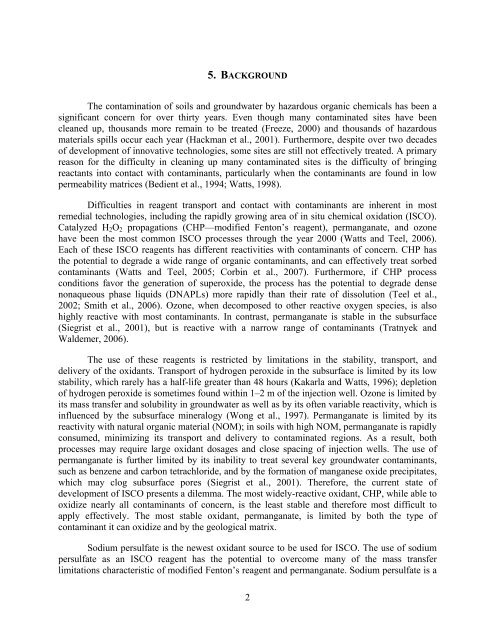Final Report - Strategic Environmental Research and Development ...
Final Report - Strategic Environmental Research and Development ...
Final Report - Strategic Environmental Research and Development ...
You also want an ePaper? Increase the reach of your titles
YUMPU automatically turns print PDFs into web optimized ePapers that Google loves.
5. BACKGROUNDThe contamination of soils <strong>and</strong> groundwater by hazardous organic chemicals has been asignificant concern for over thirty years. Even though many contaminated sites have beencleaned up, thous<strong>and</strong>s more remain to be treated (Freeze, 2000) <strong>and</strong> thous<strong>and</strong>s of hazardousmaterials spills occur each year (Hackman et al., 2001). Furthermore, despite over two decadesof development of innovative technologies, some sites are still not effectively treated. A primaryreason for the difficulty in cleaning up many contaminated sites is the difficulty of bringingreactants into contact with contaminants, particularly when the contaminants are found in lowpermeability matrices (Bedient et al., 1994; Watts, 1998).Difficulties in reagent transport <strong>and</strong> contact with contaminants are inherent in mostremedial technologies, including the rapidly growing area of in situ chemical oxidation (ISCO).Catalyzed H 2 O 2 propagations (CHP—modified Fenton’s reagent), permanganate, <strong>and</strong> ozonehave been the most common ISCO processes through the year 2000 (Watts <strong>and</strong> Teel, 2006).Each of these ISCO reagents has different reactivities with contaminants of concern. CHP hasthe potential to degrade a wide range of organic contaminants, <strong>and</strong> can effectively treat sorbedcontaminants (Watts <strong>and</strong> Teel, 2005; Corbin et al., 2007). Furthermore, if CHP processconditions favor the generation of superoxide, the process has the potential to degrade densenonaqueous phase liquids (DNAPLs) more rapidly than their rate of dissolution (Teel et al.,2002; Smith et al., 2006). Ozone, when decomposed to other reactive oxygen species, is alsohighly reactive with most contaminants. In contrast, permanganate is stable in the subsurface(Siegrist et al., 2001), but is reactive with a narrow range of contaminants (Tratnyek <strong>and</strong>Waldemer, 2006).The use of these reagents is restricted by limitations in the stability, transport, <strong>and</strong>delivery of the oxidants. Transport of hydrogen peroxide in the subsurface is limited by its lowstability, which rarely has a half-life greater than 48 hours (Kakarla <strong>and</strong> Watts, 1996); depletionof hydrogen peroxide is sometimes found within 1–2 m of the injection well. Ozone is limited byits mass transfer <strong>and</strong> solubility in groundwater as well as by its often variable reactivity, which isinfluenced by the subsurface mineralogy (Wong et al., 1997). Permanganate is limited by itsreactivity with natural organic material (NOM); in soils with high NOM, permanganate is rapidlyconsumed, minimizing its transport <strong>and</strong> delivery to contaminated regions. As a result, bothprocesses may require large oxidant dosages <strong>and</strong> close spacing of injection wells. The use ofpermanganate is further limited by its inability to treat several key groundwater contaminants,such as benzene <strong>and</strong> carbon tetrachloride, <strong>and</strong> by the formation of manganese oxide precipitates,which may clog subsurface pores (Siegrist et al., 2001). Therefore, the current state ofdevelopment of ISCO presents a dilemma. The most widely-reactive oxidant, CHP, while able tooxidize nearly all contaminants of concern, is the least stable <strong>and</strong> therefore most difficult toapply effectively. The most stable oxidant, permanganate, is limited by both the type ofcontaminant it can oxidize <strong>and</strong> by the geological matrix.Sodium persulfate is the newest oxidant source to be used for ISCO. The use of sodiumpersulfate as an ISCO reagent has the potential to overcome many of the mass transferlimitations characteristic of modified Fenton’s reagent <strong>and</strong> permanganate. Sodium persulfate is a2

















